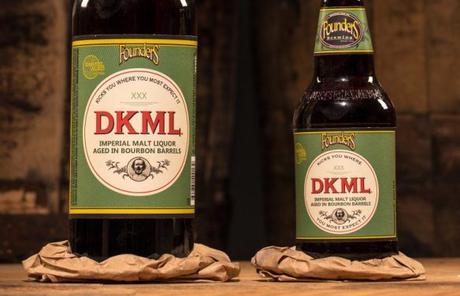
This week, Founders announced the arrival of a new beer in their barrel-aged series, DKML. A rather innocuous announcement, as these things happen all the time. There are entire websites dedicated to beer releases, after all. But from a historical perspective, it was a little different. DKML stands for - if internet circles are to be believed - Dick Kicker Malt Liquor.
For $12 a 750 mL bottle or $15 a four-pack, this latest offering provides an on-the-nose joke to its buyers not originating from the first half of its name, but its second.
When we reference malt liquor, there's a clear connotation to what we're supposed to be thinking about. We only need to look at Dogfish Head's 2009 release of Liquor De Malt to get an idea:

Plastic bottle with a plastic screw top that comes in a paper bag. It's the cliche of malt liquor and 40-ounce bottles which have long been used as a big part of defining " black beer culture." And while this is decidedly not some kind of social justice post, I did think about these connections in terms of the historical reference pertaining to Founders' latest offering and the history of a beverage that has come full circle.
Malt liquor was originally meant for affluent white drinkers. One of the malt liquor's biggest brands, Country Club, was advertised to be ideal for its namesake. As Dave Infante pointed out for Thrillist:
Malt liquor was intended to provide the boost the industry needed in the face of falling per-capita beer consumption and increasing competition from spirits and wine, and malt liquor marketers bent over backward to ingratiate themselves with the white middle class. There were Champagne-inspired offerings like Champale (one of the first malt liquors, introduced in 1952), Champetite, and Sparkling Stite (which billed itself "Pale & Dry as Champagne"). There were enough WASPy references to fill a white-privilege bingo card: Country Club, of course, but also University Club, Olde English, and Town & Country V.V.S. There was even a reference to a founding father: Patrick Henry.
Hit that Thrillist link for a full history, but in a general sense, we know what actually happened from there. Malt liquor didn't perform well with its intended audience, but it did sell in urban areas to black customers.
Which all presents an interesting situation, from a historical and cultural perspective, of where we are now, with a $15 barrel-aged malt liquor hitting shelves billed as "the first malt liquor worthy of a glass" with the tongue-in-cheek "warning" that "this one's a pry-off, not a twist-off." There's a wink and a nod here, of which I'm sure is not meant to be malicious or mean or with anything less than a playful gesture that assumes a beer enthusiast buying this beer has an idea - stereotypical, cliche or otherwise - of what malt liquor is supposed to be about, but this time, it's made for them.
And who "they" are now is very different from who "they" were 40 years ago.
But even still, there are broader issues at play related to issues of masculinity (especially black masculinity) and cultural heritage within the realm of beer. Issues of diversity and equality are topics raised numerous times on this blog, and the reappearance of malt liquor - even as a specialty one-off - could be seen as a good thing as much as a callback to an antiquated time of more segmented marketing.
America's social values have shifted dramatically in the last half century, especially in the ways we consider strength, gender and their place within our culture. While 40s of malt liquor may still have a place among all the other options of alcohol available to us, wine, beer and spirits have become more free flowing in their acceptance in price point, accessibility and varieties. Malt liquor, once a defining feature of something like rap, doesn't have the same cache it once did.
Which piques my curiosity of Founders' latest entry. Yes, it's clear they're having a little fun, and it's subjective whether that fun is good, bad, somewhere in between or nothing to consider at all, but it still offers up an opportunity for contemplation. For what it's worth, the conversation within this Reddit forum is concerned about DKML's quality, especially in relation to Founders' other highly-regarded barrel-aged brews. There are many complexities connected to the history of malt liquor, so a prominent American craft brewery jumping on board may be simple fun or it may come off as questionable. It's all up to you.
No matter what the answer is, there's no denying the discussion to be had around it could be an interesting one.
Bryan Roth
"Don't drink to get drunk. Drink to enjoy life." - Jack Kerouac

